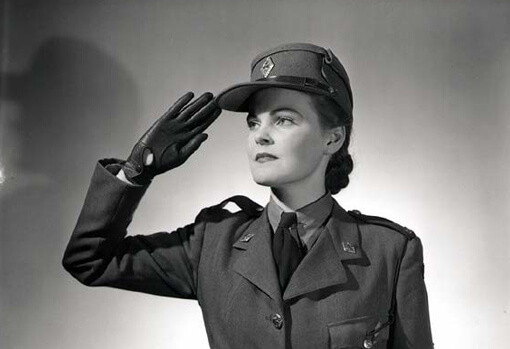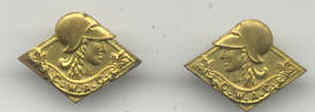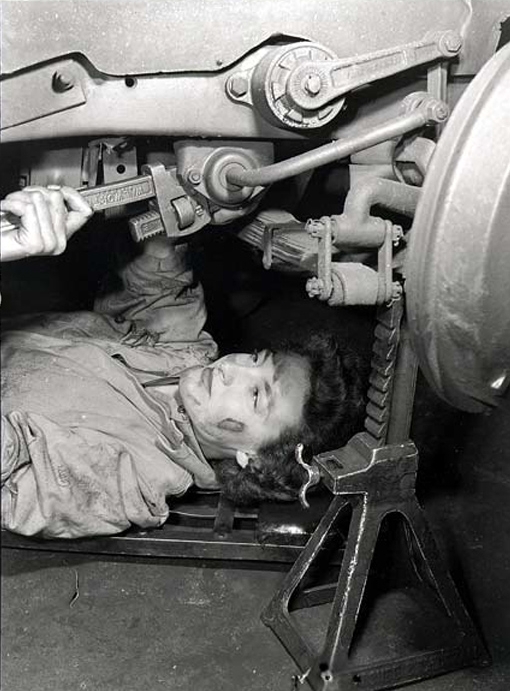
Canadian Women’s Army Corps member. [Wikimedia]
In some ancient civilizations women have been taken seriously in battle. There is Athena, a Greek goddess of war, who in Homer’s Iliad used her civility, intelligence and prudence to be even more effective than the male god of war, Ares. Her superior qualities are even marked upon her, dawning an aegis, or breastplate, which symbolizes the skills that lead her to victory.
Athena’s influence is found stretching into Canada’s military history, with the Canadian Women’s Army Corps (WAC) wearing a collar badge of the Greek Goddess’s head.
These 21,624 Canadian women refocused the male military gaze, challenging pre-existing notions that war was reserved for men only. And with skills and passion not unlike Athena’s very own, the WAC proved that women could be a vital artery to the war effort. Through their precedent, the WAC served as Canada’s first official female military organization, pioneering women’s rightful roles in the Canadian Armed Forces as men’s equals.
Before their formation 82 years ago, women participated in different military enterprises sporadically from the North-West Rebellion to the South African War.
“Down through the centuries women, historical or mythical, had participated in wars,” military historian C.P. Stacey wrote in a declassified army report.

Collar badges depicting the Greek Goddess head. [canadiansoldiers.com Mazeas: S.35 Bill Ellis]
This would change with the advent of world wars, dramatically enlarging the scope of armed combat. In 1918, Ottawa, feeling the emergency of the First World War, had planned to form a “Canadian Women’s Army Auxiliary Corps.” A female organization meant to “free up” space for men to serve in combat. The war ended before the plan could take effect.
But when another world war erupted in 1939, Canadian women weren’t going to wait for top brass to catch on. So, with Joan Kennedy at its helm, the women of Victoria, founded the British Columbia Women’s Service Corps.
This feminine flame for patriotic rebellion soon ignited across the country with other provinces like Ontario, Quebec and the Maritimes hosting their own version of Kennedy’s group. They spent their own time and money, and volunteers would practise infantry drills and take military courses on Morse code signalling and map reading.
“There were few precedents,” Dundas and Durflinger wrote.
Witnessing the British army’s own inclusion of women, Kennedy and other volunteers began lobbying for a women’s auxiliary service in 1941, and with increasing strains on manpower for the fighting forces, it didn’t take much convincing.
“A D. Org memorandum noted that ‘clerks and cooks are definitely needed now and Civil Servants will not be suitable,’” Stacey wrote.

A Canadian Women’s Army Corps private tightening springs on a vehicle in England, 1944. [Wikimedia]
“The images of ‘women as warriors’ did not fit most mid-century gender stereo-types,” Dundas and Durflinger wrote.
One WAC veteran recalled, “if people saw a boy and a girl walking hand-in-hand they’d say, ‘Oh, look at that nice young couple.’ But if the girl was in Army uniform, they’d say, ‘Oh, look at that cheap WAC.’”
Mocked within and outside the military, WACs didn’t let this dim view detract them, with 350-430 new enlistments being sent to Kitchener, Ont., for basic training each month. And while over 90 per cent stuck to administrative and clerical work, some women rose to be gifted ciphers, mechanics and signallers–even when their pay was two-thirds of a male soldier’s.
“Col. Royal recommended that women be given basic pay equal to that of a man,” Stacey wrote.
Even though their pay would never equal a man’s, despite a 1943 pay increase, the women hardly complained because they were provided with opportunities they could’ve never imagined as civilians. Getting to choose from 55 trade categories, some 3,000 WAC members even got to serve overseas in Britain, Italy and Germany.
Though the WAC wasn’t without its organizational challenges, with Stacey noting its propensity for duplicate or unnecessary roles, it remained a staggering success by the time of its disbandment in 1946. By their own Athenian grace, the WAC helped Canada win the war.
Advertisement





























